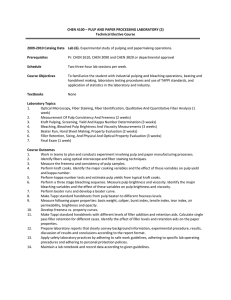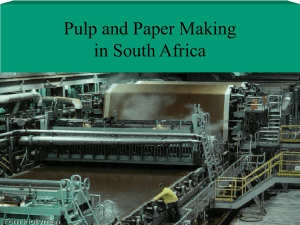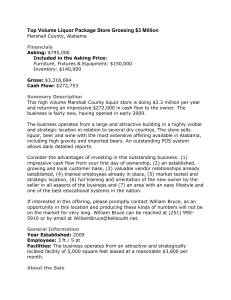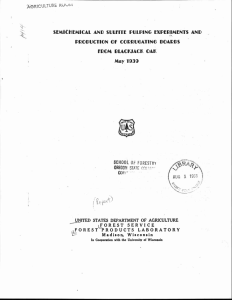utilization of lime-mud as filler in paper making
advertisement
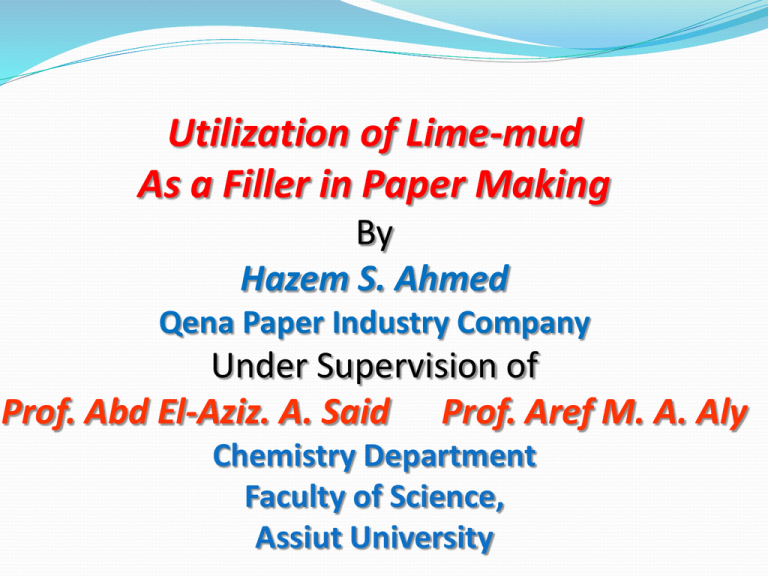
Utilization of Lime-mud As a Filler in Paper Making By Hazem S. Ahmed Qena Paper Industry Company Under Supervision of Prof. Abd El-Aziz. A. Said Prof. Aref M. A. Aly Chemistry Department Faculty of Science, Assiut University Outline Introduction Aim of the work Experimental Results and discussion Conclusion Introduction LIME-MUDE DEFFINITION Lime mud is a waste byproduct generated by pulp and paper mill industry, and collected from the kraft pulping chemicals recovery process. Bagasse the most fibrous raw material available and suitable for paper making in Egypt, is the sugarcane residue after sugar extraction. The ultimate goal of chemical pulping is to liberate cellulosic fibers by lignin removal (delignification) without degrading or removing fibers. Pulp plant consists of four main processes as follow 1st • pulping 2nd • washing 3rd • Screening 4th • Bleaching Pulping In the Kraft pulping process, bagasse mixed with aqueous cooking liquor “white liquor” composed mainly of sodium hydroxide (NaOH) and sodium sulfide (Na2S), in pandia under pressure and temperature conditions to separate the cellulosic fiber from the natural lignins washing Washing filters economically remove the maximum amount of dissolved organic and soluble inorganic material present with pulp mass with the minimum amount of fresh or reused processed water, to prevent any interference with bleaching or papermaking chemicals screening Screening systems are installed to selectively remove certain constituents from a pulp feed, so that the accepted pulp is more suitable for the paper making bleaching is the chemical treatment of cellulosic fibers to increase brightness by decolorizing or dissolving the colored components in pulp, principally lignin to increase the visual quality Paper Machine Bleached pulp mixed in a furnish with wood pulp and other chemical additives (filler, dye, retention aid, AKD, starch) to produce the paper roll Return back to washers in pulp plant The filtrate of washers called black liquor. black liquor contains, aside from the original white liquor chemicals, lignins and other organic matter. Black liquor supplied to recovery plants to recover and recycle the costly pulping chemicals . the black liquor is concentrated in multiple-effect evaporators . Evaporators Black liquor delivered as a concentrated fuel to a “chemical recovery boiler.” recovery boiler combusts the organics under unique oxidizing/reducing conditions to a molten inorganic ash (“smelt”) consisting primarily of Na2S and Na2CO3. The smelt is drained from the recovery boiler and quenched in water to create the “green liquor.” The green liquor is delivered to the “slakers” to initiate conversion of the dissolved Na2CO3 into NaOH required in the white liquor. This slaking process utilizes calcium oxide CaO to convert Na2CO3 into NaOH via the following two consecutive reactions: Recovery boiler Slaking process CaO(s) +H2O→Ca (OH)2 Na2CO3(aq)+Ca(OH)2→2NaOH(aq)+CaCO3(s) CaCO3 is the lime mud waste produced from chemicals recovery in pulp and paper manufacture. Experimental Lime-mud obtained from the recovery plant was dried and then the alkali loss was measured. It was subjected to full chemical analysis, particle size determination and optical properties. The study included the effect of washing with hot water at different temperatures on the removal of alkali loss and dissolved silica then another full chemical analysis was conducted. The study was also performed on the effect of grinding process on the particle size distribution using constant volume and changing the time of grinding. The optical properties which include: brightness, opacity, scattering coefficient were determined as well. Results and Discussion Lime-mud obtained from the recovery plant was subjected to full chemical analysis, particle size determination and optical properties. SiO2 4.85 Al2O3 Fe2O3 CaO MgO Na2O K 2O SO3 TiO2 P2O5 L.O.I 0.01 0.03 51.13 0.01 1.45 0.01 0.39 0.01 0.11 40.95 % on diameter 2µm Alkali losses as Na2O brightness 14.970 % 1.45% 85 AVAILABILITY TO USE AS FILLER? From results in the table we can see that we are facing three problems to use lime-mud as filler in papermaking as follow Brightness must be increase to about 90% iso 2. Removing of alkali losses and dissolved silica 1. 3. Particle size must be 2µm and its portion is about 70% Alkali losses and dissolved silica removal The effect of washing with hot water at different temperatures on the removal of alkali loss and dissolved silica was carried out then, full chemical analysis was conducted. The best results achieved when washing was carried out at 90°C.The alkali losses decreased to 0.55% and silica decreases to 3.5%. The washing filtrate will be used in quenched of smelt to obtained the green liquor. temperature Loss as Na2O% SiO2 3.5 60°C 70°C 80°C 90°C 1.45% 0.86% 0.84% 0.55% Al2O3 Fe2O3 CaO MgO Na2O K 2O SO3 TiO2 P2O5 0.01 0.02 54.39 0.01 0.55 0.01 0.01 0.01 0.1 L.O.I 41.28 Particle size distribution Relation between time of grinding and particle size Particle size distribution Relation between time of grinding and particle size Raw sample direct from the filter Drying and grinding for1 min Washed, drying and grinding Washed, drying and grinding CaCO3 for10 min for 5 min 15.0891 4.2952 Diameter on 10% µm 0.3985 0.3876 Diameter on 50% µm 15.0891 4.2952 Diameter on 90% µm 29.4304 10.3031 % on diameter 2µm 14.970 % % on diameter 3µm median µm 0.5762 0.2179 0.5762 Filler sample 0.5208 1.6230 0.1771 0.7684 0.5208 1.6230 9.3428 6.3470 32.741 % 70.515 % 71.764 % 73.178% 15.717 % 39.730 % 74.356 % 77.788 % 95.119% % on diameter 4µm 16.679 % 47.549 % 77.443 % 82.387 % 99.417% % on diameter 5µm 17.925 % 55.917 % 80.262 % 86.45 % 90.993 95.903 2.8552 2.0094 % on diameter 10µm Mean µm 15.7194 Brightness iso 85 d98 (top cut) 5.2788 90.2 18.1890 3.6730 1.97 95.7 97.8% 12.474 6.9733 Brightness increase Reason for brightness decrease due to black spots in the lime-mud. Black spots are formed through combustion of sulpher compounds in the boiler. A new filtration method was adopted to the green liquor before the slaking process to remove the black spots. Brightness increases after this step from 85% iso to 95.7% iso. Pilot scale Paper making research plant Two sets of paper sheets were made in the research plant. 1st set using the same furnish in the paper machine using exported calcium carbonate as filler 2nd set using the same furnish in the paper machine using treated lime mud sample as filler Optical and mechanical properties were measured optical and mechanical properties for paper sheets, where sample1, is paper sheets made by using exported calcium carbona Calcium Carbonate Treated Lime-mud 66.03 62.94 µ 400 390 BULK cc/g 1.51 1.55 MOISTURE % 6.67 5.88 TENSILE INDEX Nm/g 53.97 58.64 BREAKING LENGTH METER 5500 5980 TEAR INDEX mNm2/g 7.27 7.01 73.93 71.52 3.93 3.98 40.06 40.56 227 206 SUBSTANCE THICKNESS g/m2 TEAR FACTOR BURST INDEX Kpa m2/g BURST FACTOR Air permeance ml/min OPACITY (ptg) % 80.89 78.73 Sc COEFFICIENT m2/kg 36.99 34.15 YELLOWNESS % 5.96 4.65 Conclusion Tests made in this study showed that lime-mud after washing and drying is an important source of crude carbonate which (due its chemical properties and natural potential) can be used in paper making industry as a filler in coated paper with the following superior properties: 1. Chemical content (loss) and drigs removed. 2. Brightness is suitable for papermaking 3. Lime-mud particles size becomes smaller and percent of 2 µm increases gradually with increasing time and become more suitable for paper making. Thank you for your attention
